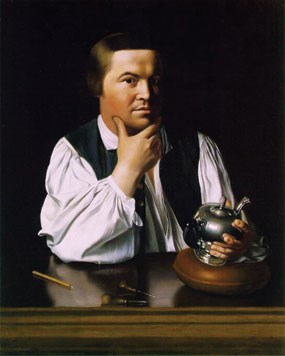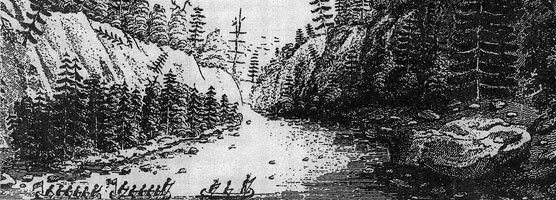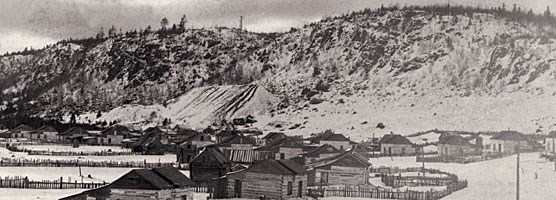At least 8,000 years agoThe earliest known metalworking in North America begins when Indigenous Peoples start mining copper on the Keweenaw Peninsula. They dug shallow mines and used heavy stones to break waste rock away from copper masses. The copper was used to fashion bracelets, beads, tools, fishhooks, and other items for trade. Objects made of Keweenaw copper have been found in archeological sites across the continent. 
1600s and 1700s1621Etienne Brule was sent by the French on a mission to learn the Ojibwe language and build a trading relationship with the many independent Ojibwe bands (NatAm 38). They must have been persuasive, for by the mid-1600s the Ojibwe had allied themselves with the French and were well-engaged in the fur trade. The Keweenaw was certainly rich territory: in 1659, the explorers and traders Pierre Radisson and his brother-in-law Medart Chouart Sieur des Groseilliers paddled along the south shore of Lake Superior to Keweenaw Bay, where they encountered an industrious population of beavers, pieces of native copper, and a convenient, well-established portage route that made traveling across the lake much easier (NatAm 39). Ten years later, Jean Talon, the man in charge of the colony of New France, sent Louis Joliet to “find the copper mine from which pieces of pure copper had been brought.” Although he failed to locate it, his journey was one among many which opened the door for French priests to establish thriving missions around Lake Superior (NatAm 40). 1771Alexander Henry makes the first English attempt to mine copper on the Keweenaw Peninsula near the Ontonagon River. At the time, the nearest English settlement is nearly 300 miles away at Sault Saint Marie and the region is completely undeveloped and mostly unmapped. Poor planning cripples Henry's adventurous spirit, and in the spring of 1772 his mine collapses after producing little copper. "The copper ores of Lake Superior can never be profitably sought for but local consumption. The country must be cultivated and peopled before they can deserve notice." - Alexander Henry 1776Delegates to the Continental Congress convene in Philadelphia and on July 4, 1776, adopt the Declaration of Independence. 
Museum of Fine Arts, Boston 1800s1801Paul Revere, who would later be made famous in H. W. Longfellow’s poem "Paul Revere's Ride," creates the Revere Copper Company, the first copper rolling mill in America. This Massachusetts-based company specializes in copper roofing and sheathing for ships. The limited U.S. supply of copper forces Revere’s company to import most of its metal. 1803The United States agrees to pay France $15 million—about $417 million in today’s money—for the Louisiana Territory, which comprises about 830,000 square miles and extends west from the Mississippi River to the Rocky Mountains. The addition nearly doubles the size of the country and includes rich copper deposits in the area now within the state of Montana. 
1820While leading an expedition through the Upper Peninsula, Michigan Territorial Governor General Lewis Cass visits the Ontonagon Boulder, a large piece of float copper along the Ontonagon River. 1837Michigan becomes the 26th state admitted into the Union. The Upper Peninsula is added to Michigan after the state relinquished its claim to land around Toledo, Ohio. Although Michigan was hesitant to accept the new peninsula, this land ended up being rich in copper and other metals that brought great wealth to the state. 1840Douglass Houghton, state geologist of Michigan, publishes a report on the geology of the Upper Peninsula and describes the Keweenaw's copper deposits. Despite his appeal for caution, a land rush would soon start as investors, miners and entrepreneurs attempt to acquire copper-rich real estate. 1842The Ojibwe sign the Treaty of La Pointe, ceding their mineral-rich lands in the Upper Peninsula to the United States. As part of the agreement, the Ojibwe would retain hunting and gathering rights in their ancestral homelands in the Keweenaw, the rest of the Upper Peninsula of Michigan, and parts of northern Wisconsin. 1843The United States Government opens a mineral land agency office in Copper Harbor. 1844The Pittsburgh and Boston Mining Company begins mining near Copper Harbor. The operation is abandoned in 1845 after a $28,000 (about $1.2 million in today’s money) investment, but only $2,968 ($124,000 today) returned. Though the company produced little copper, it was the first serious American mining attempt.
The U.S. army builds Fort Wilkins in an effort to protect copper interests in the Keweenaw. Although the site was only garrisoned for five years and was permanently abandoned in 1870, the site now houses Fort Wilkins State Park, a heritage site of Keweenaw National Historical Park. 
Keweenaw NHP Archives, Jack Foster Collection 1845The Cliff Mine near Eagle River opens. It is the first large-scale, profitable mine on the Keweenaw Peninsula. Before it closes in 1870, Cliff Mine rewards its investors with $2,519,000 ($104 million today). 1846The Portage Mining Company and the Northwestern Mining Company resolve a land lease dispute by forming the Quincy Mining Company. After exploring the hillside above Portage Lake, the company digs its first shaft in 1848. 
Harper’s Weekly, 1860 1848On January 24th, gold is discovered at Sutter’s Mill in the Sierra Nevada mountains of California. The Gold Rush will reach its height by 1849, with prospectors moving to the area from all over the world. Although this mineral rush is the more well known one, very similar events were occurring with Keweenaw copper in this same time period. |
Last updated: May 7, 2025
